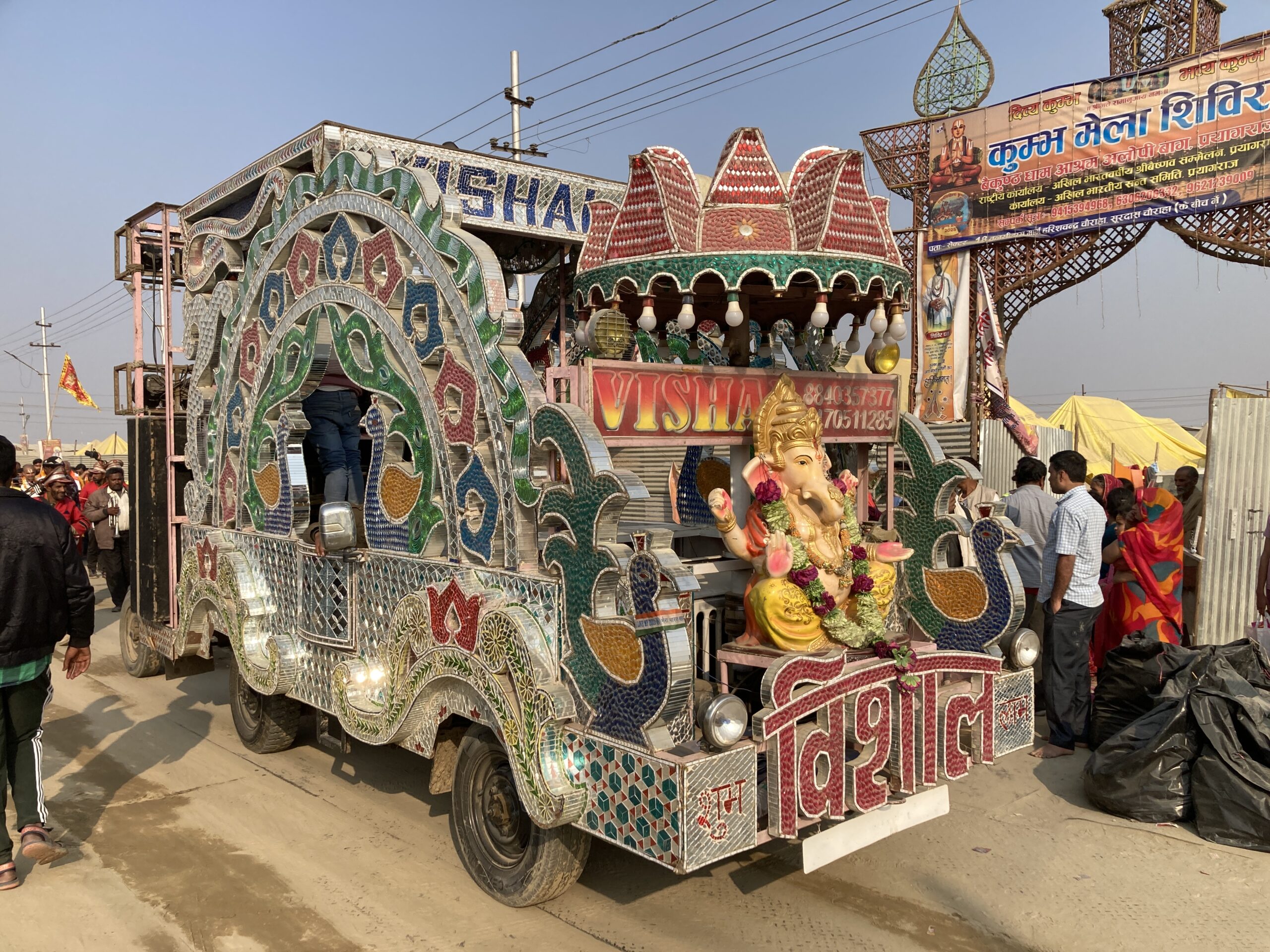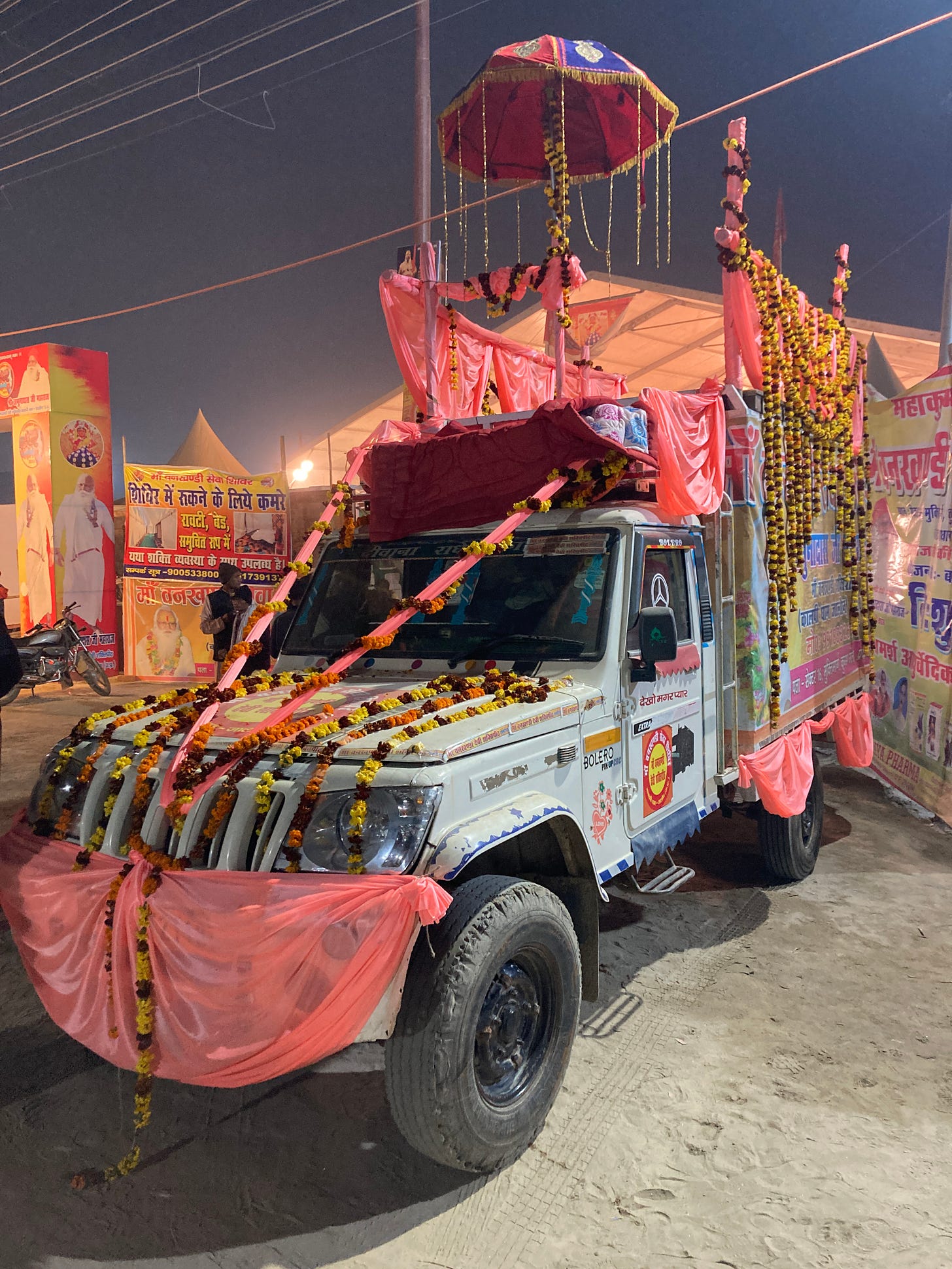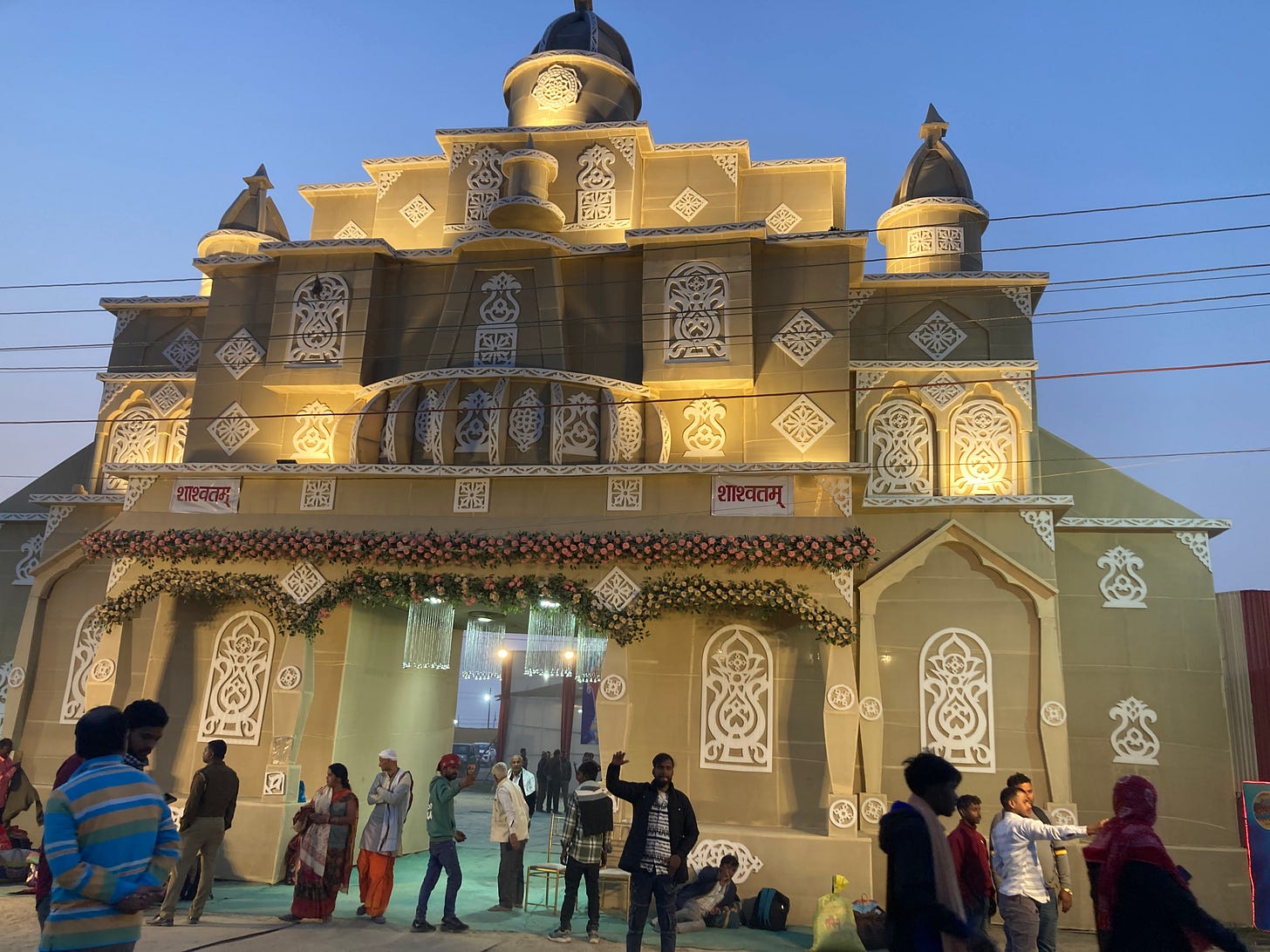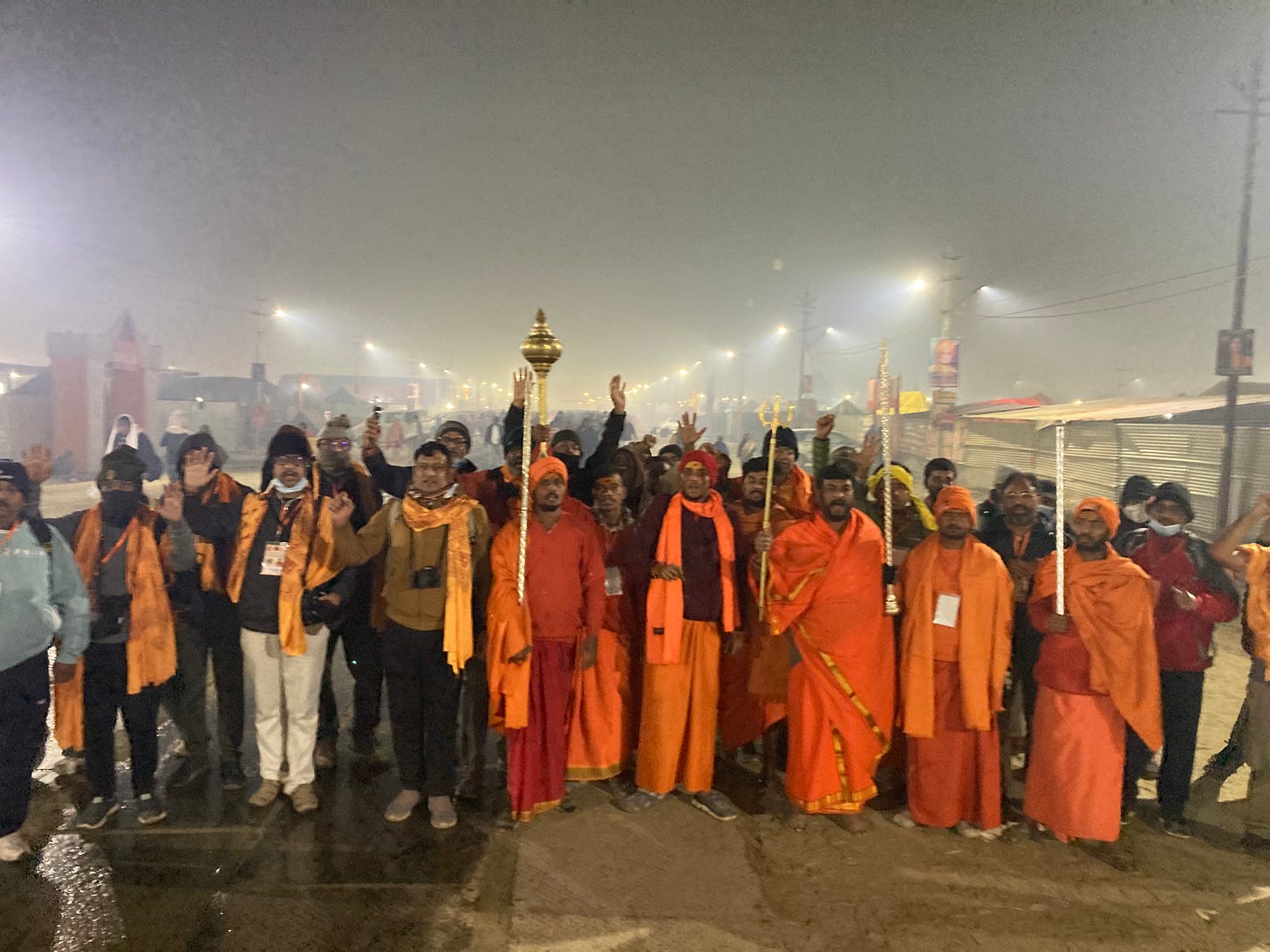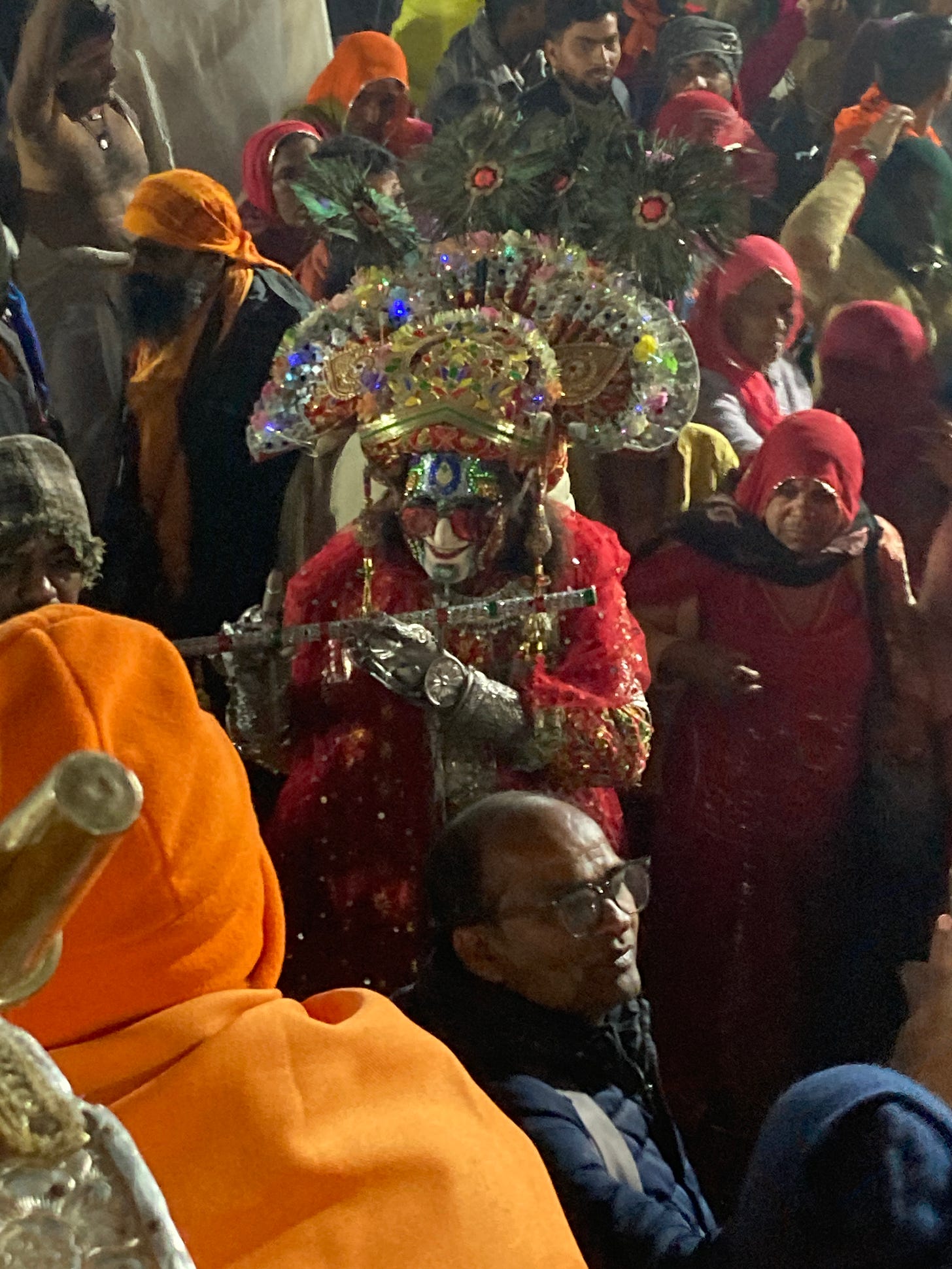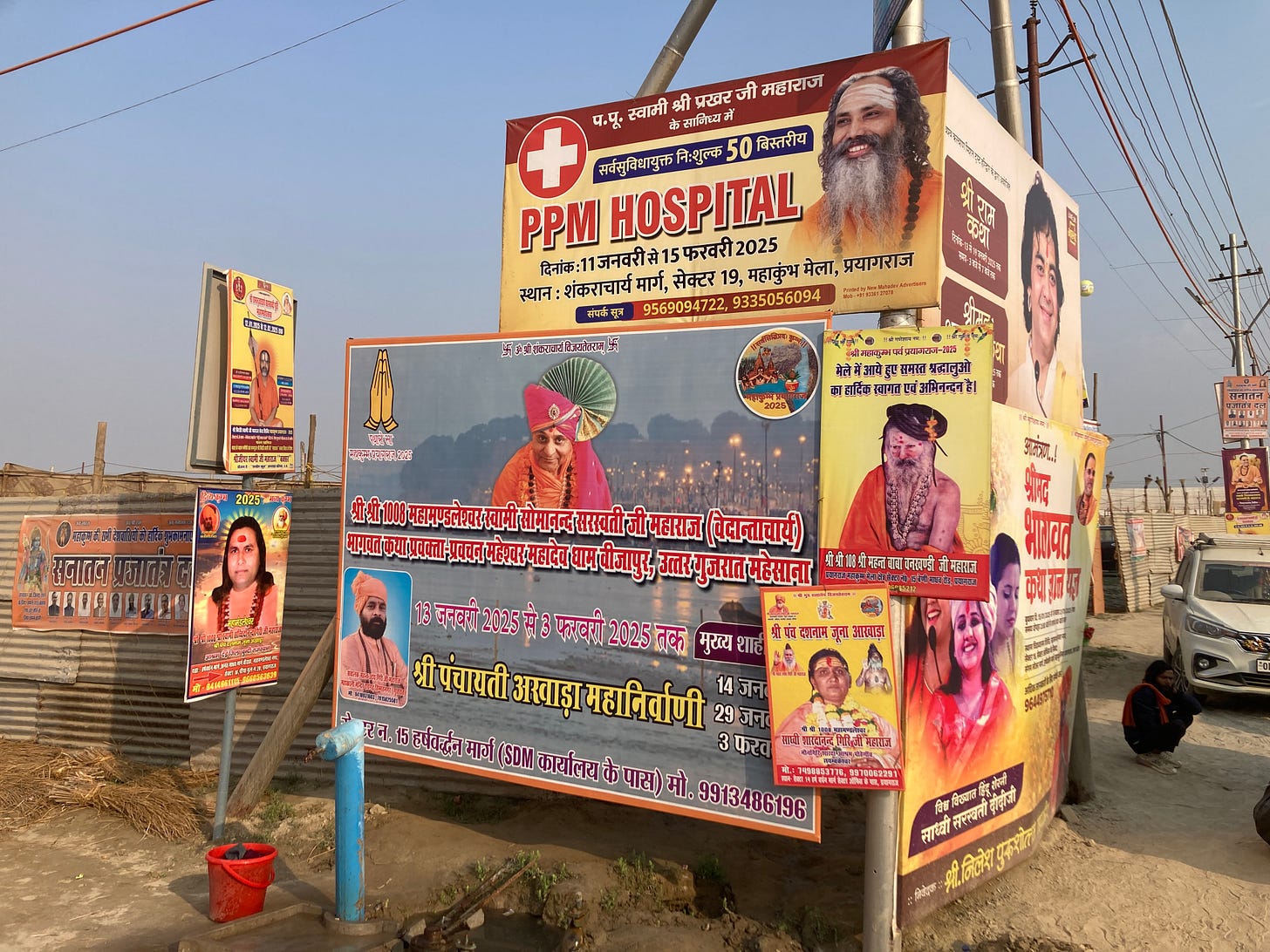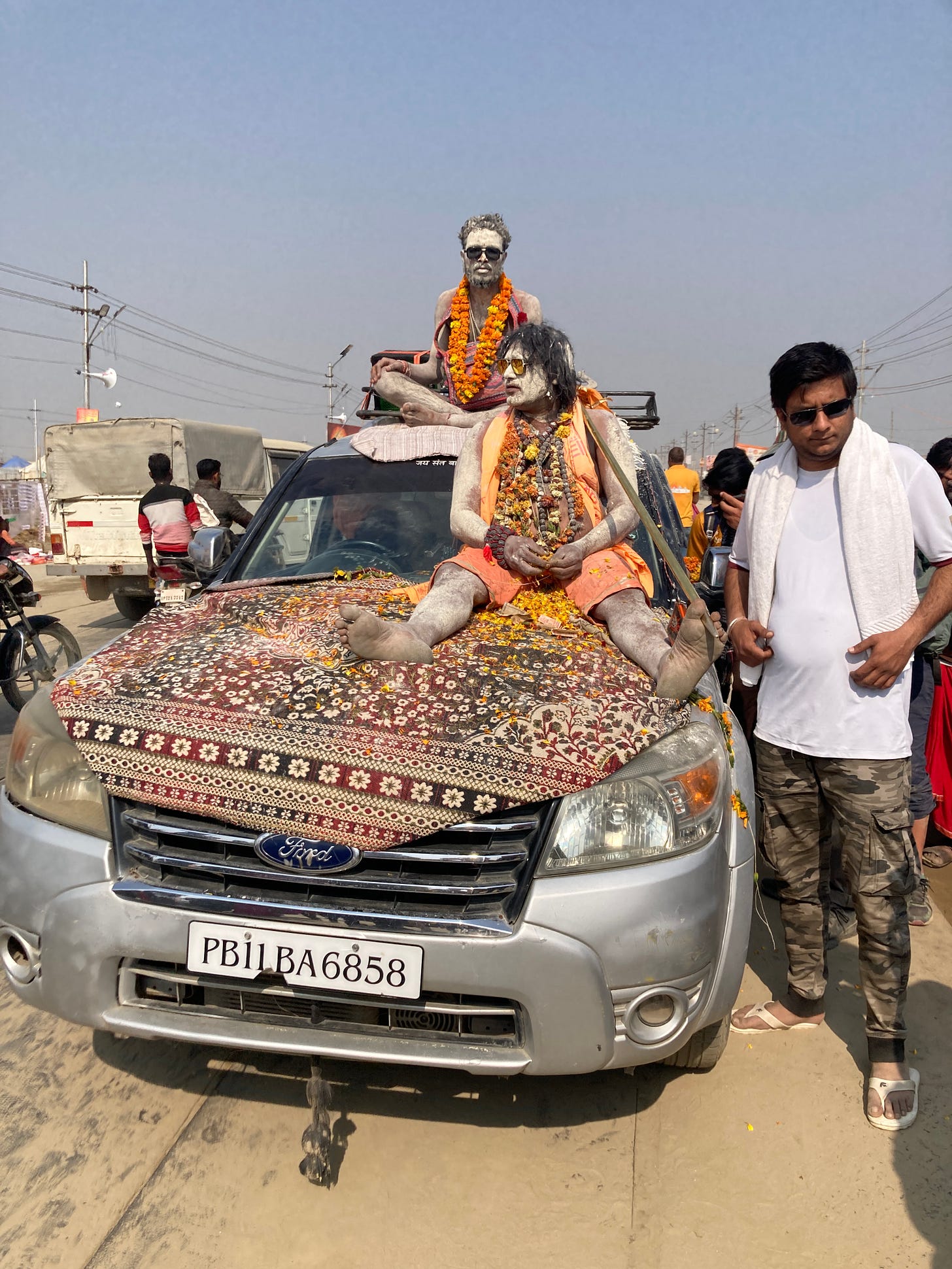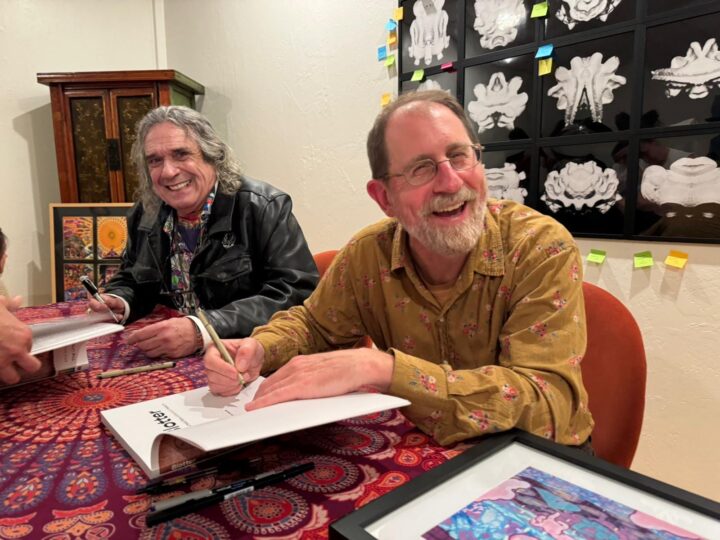Growing up in Southern California, I was exposed early and often to the mind virus of Disneyland, the mother of all theme parks and, at least if you read Philip K. Dick or Jean Baudrillard, ground zero for the Age of the Simulacrum. This infection does something to a person. Even now, my Magic Kingdom imprinting makes itself known when I travel to places where they had, like, actual kingdoms. I’ll stroll into a National Trust castle or the consumer-friendly medieval quarter of Tallinn, and a little orienting device goes off deep in my core: “It’s like Disneyland!”
A similar psychogeographical wobble occurred recently in India. In late January, Jennifer and I traveled to Uttar Pradesh to attend the Maha Kumbh Mela, a Hindu mega-event of the highest order and, as you have probably already heard, the largest gathering of humans on the planet. Over a six-week period, determined by the sidereal dance of the sun, moon, and Jupiter, hundreds of millions of people made their way to Prayagraj (formerly Allahabad). More specifically, pilgrims were aimed at the triveni sangam: the confluence of the rivers Ganga and Yamuna, which are both Google-mappable, as well as the invisible or mythical Sarasvati. Here people would ritually bathe, rinsing away their tangled mortal karmas in the cold, polluted, sacred waters, especially on three particularly auspicious “royal bathing” (Shahi Snan) days. Many of these millions were poor villagers who spent their meagre savings to make the trek, but many were also VIPs, or fat slices of the exploding middle class, or cave yogis rocking esoteric sidhis, or hawkers of goods, or global media, or alternative travelers like us.
The central myth behind the Kumbh is the churning of the ocean of milk, my favorite of the world’s mythic cosmogonies. Back at the beginning of things, the devas and asuras (roughly, gods and demons) decided to work together to obtain amrita, the nectar of immortality. Together, using a snake and a mountain, they churned the milky sea until a kumbh (pot) containing the divine nectar appeared. Breaking the truce, the asuras tried to seize the vessel, so Jayant, the son of Indra, dashed off with the pot. During his twelve-year flight, four drops of amrita fell on four locales: Prayagraj, Haridwar, and two other spots (Ujjain, Nashik) where Kumbh Melas are sometimes held.
Back here in history, the Kumbh Mela’s aura of ancient, even timeless continuity may be more fabricated than at first appears, at least in Prayagraj. In her book Pilgrimage and Power: the Kumbh Mela in Allahabad, 1765-1954, Kama Maclean argues that Kumbh Melas are indigenous to Haridwar. But, while there was a well-known (and more carnivalesque) annual fair or mela in Prayagraj for centuries, there is no historical record of a “Kumbh Mela” in that locale until the middle of the 19th century. Yet the Prayagraj sangam is now considered the pre-eminent site for a “holy dip”. Though her argument is debatable, Maclean suggests that the growth of the mega-popular pilgrimage site has in part to do with the demands of Indian nationalism over the last few centuries, and especially the need, in such an insanely diverse land, for an imagined national community.
Right in sync, this year’s Kumbh served as a massive promotional opportunity for Hindu nationalist leader Modi, who is actively remaking (and arguably flattening) Hinduism into a national identity rather than a highly variable regional reality. Kumbh-themed billboards and advertisements featuring Modi were everywhere in the airport and along the road from Varanasi, not to mention saturating the fairgrounds. Modi was often photo-shopped alongside the bald Yogi Adityanath, a former monk who now serves as Chief Minister of Uttar Pradesh and that some see as the next BJP bossman.
But these complexities faded into the background as Jennifer and I, after a long taxi drive and a short Mr. Toad’s Wild Tuk-tuk Ride, walked those final kilometers into the site. Finally stepping off the asphalt, we descended onto the sandy earth flats ceded by the Ganga every year when the river retreats following the monsoon rains. We joined throngs of pilgrims lugging their gear through wide avenues lined with large canvas-walled camps fluttering in the mild breeze. We were gently amazed: we had arrived, after months of planning and some considerable logistical difficulties, at the pulsing mystic heart of one of the planet’s most ancient and god-mad lands.
And how did my little psychogeographical compass read? “It’s like Burning Man!”
I totally get how trivial and American (or Californian) this is. The difference in scale alone makes the comparison absurd. But hear me out. We had entered a well-engineered temporary city laid out in a large grid on a sandy plane where nature herself would assure that no trace was left. Over the ensuing days we would encounter countless colorfully festooned trucks, tractors, and sedans that resembled art cars but that we came to call “babamobiles.” We experienced exhausting intensity, unexpected cold, and dusty treks back to the tent long after the (religious) ecstasy had fled. Trucks overwatered the dusty ground and turned it into mud. There were blinky lights, bullhorns, penises on display, and intensely interfering sound systems. The sacred danced with the profane, including acrobats, streetside tatooists, marching bands, and trance beats. Bleary morning hunts for caffeine. Imaginative architectures fashioned with cheap materials. Extraordinarily varied headgear. And, at least in an echo of the earliest Burns both Jennifer and I attended, the palpable presence of actual risk.
Another echo was the existence of many plug-and-play camps for VIPs and the relatively wealthy, one of which, in a decidedly non-risky strategy, Jennifer and I were marching towards. I won’t name the glamping outfit, but they had entered into an unusual relationship with one of the seemingly thousands of swami camps that were located within the downtown mela zones controlled by the akharas, or sadhu monastic orders. These camps usually took up a fair bit of real estate, and often announced themselves with colorful signs featuring the wise, radiant visage of the resident godman (or, occasionally, godwoman — the term is common in South Asian argot). Some camps went in for fantastical structures — we saw many medieval castles, one vertical space shuttle, one large whirling damaru, and, at the popular and well-positioned ISKCON camp, massive janky animatronic figures of Krishna, Garuda, and Hanuman. The facade of the following Cinderella’s Citadel was fashioned with canvas and carved styrofoam.
The camp we were headed towards was part of the Juna Akhara, one of the largest and most ancient Shaivite orders. Many members of the akhara — but by no means all — are naked, dreaded, and ash-covered ascetics, the classic image of the Kumbh holyman. But while sadhus are certainly known for their hardcore austerities and world renunciation, they historically also regularly served as mercenary forces, a legacy that remains apparent today not only in the ceremonial weapons they often wield but in their sometimes belligerent behavior. Scores of Haridwar Kumbhs over the centuries have featured open violence between akharas, especially between team Shiva and team Vishnu, with hundreds and sometimes thousands killed. Not infrequently, the beef is over the order of the bathing precession on Shahi Snan days. During the 1998 Kumbh Mela in Haridwar, the conflict between the Juna Akhara and the Hindu nationalist administrators of the event devolved to the point that the latter called in paramilitary forces to quell the conflict.
Our camp featured no naked babas, and seemed a relatively low-key affair. There was the swami, a quick-witted female teacher who led kirtan, and a couple dozen devotees and monks from the main ashram in Varanasi. And of course, a handful of high-paying guests like us. Except that, as the manager informed us upon arriving, our booking was actually at the other camp the glamping outfit was running, which was 15 kilometers away. I’ll spare you the blow-by-blow, but the ensuing hassle did bloom into that almost magical liminal zone, not unheard of in South Asia, that combines grift, humor, opportunism, storytelling, fuckups, gruff comradery, and the art, or threat, of the deal. Let’s just say that by the evening we had donated a substantial amount to the ashram, and found ourselves with a pleasant tent all our own.
But there was little time to relax. Early the next morning, at around 4 am, the second Shahi Snan would begin when the first pack of naked ascetics raced to the sangam to dip. As campers, we were entitled to join the ashram crew as they made their way to the waters after the sadhu spree, following a more orderly procession that took the form of a parade of floats (aka, art cars) associated with the various akhara divisions. We napped a few hours, and woke and gathered a little after midnight.
Immediately the women, including Jennifer, were bundled off into two small cars that would conduct them directly to where the ashram float was waiting in line. That left me with a few dozen male devotees, who strode off from camp with great vim and vigor the front line, brandishing tridents and banners and barking out sacred cadences. I hadn’t had time to meet anyone, and many did not speak English, but there seemed to be at least as many middle-class followers as full-on monks. The crew:
I felt a bit like a fish out of Ganga striding along with these passionate devotees in orange, but I got into the rhythm and soon fell in with a young man who was also a glamping guest. He was a logistics whiz from a privileged family who worked in Pune for a Utah e-commerce giant. He wasn’t particularly interested in holy men, but was exploring in a “spiritual but not religious” way. It was good to have a buddy.
As we moved along, the crowds got thicker and thicker and it took more concentration to remain together. The chants helped. Finally the crew approached a row of art cars, and we could see the ashram float and the ladies. But there was a fence between us and the floats, not just a single fence but two parallel barriers about six feet apart. These, we would soon learn, were patrolled by Indian police brandishing the long thin clubs called lathis. Some of our advance party scampered over the two fences, whose railings were about four feet high. But the cops soon appeared, and there was no way the bulk of us were going to make it. The word went out that there was a passageway in the fences further in the direction we were already walking, so we flowed with the now thoroughly claustrophobic human sea to our rumored ford. It wasn’t far, though it took twenty minutes to get there. Once again, some of our advance party made it through. But then the police inexplicably decided to close the passageway, which was performed right in front of me with barely restrained thuggery.
At this point the only person from our crew I could see was Vivek. We held hands and turned to face a total cluster-fuck. We decided to head back upstream towards the float and try to find a good place to jump the fence. Punk rock mosh pit skills kicked in and I maintained a reasonably cool head as we propelled ourselves through a confused, tense, and occasionally aggressive crowd. Everyone could sense the crushing possibilities in the air. We struggled our way back to the fences. Despite the red fire blazing in the eyes of the cops patrolling the boundary, who would lunge after the occasional scofflaw, there was no other obvious option.
Vivek went first. He clambered over the first fence, landed fleetly in the passageway between the barriers, and then quickly scrambled over the second fence. A cop inside the passageway ran towards him at the last moment but decided not to hop the fence himself and go after him. My turn. I waited for a short spell but didn’t overthink it. When I didn’t see any cops in the immediate vicinity, I thrust up onto the first fence, placing my right foot squarely on top of the railing as I prepared to climb down into the passageway before scrambling over the second fence. Out of the corner of my eye I saw a cop turn around inside the passageway and immediately barrel towards me with lathi raised. I flashed that if my feet landed in the passageway I would probably enter a very shitty movie, so I thrust myself forward from the railing, bounding over the space instead. My left foot landed solidly on the far railing, and I propelled myself to a running landing. I quickly found Vivek, who, like me, was shocked that this grizzled Yank not only attempted but actually executed a stunt with such relative audacity. “Mission: Impossible!” he cried. I silently thanked Hanuman.
Soon we found our crew and the long wait began, a wait that could not but recall those many nights on top of some equally outrageous art car, waiting in the clamor and growing chill for the man to burn. As luck would have it, we were placed right next to to the Kinnar Akhara, a group of transgender spiritual leaders who were accepted into the larger Juna Akhara in 2019, only five years after the Supreme Court granted Indian citizens the right to self-identify as male, female, or “third gender.” The Kinnar were vibrant, regal, and cordial, but also on sacred display. A few of the folks who approached them for blessings (particularly for childbirth) had amazed looks in their eyes, as if they were in the presence, not of religious experts, but of demi-gods. Some figures in the crowd around us even looked like demi-gods to me.
After many hours, a palpable wave of concern ran through the crowd. Soon the camp swami appeared with a megaphone, gravely announcing that there had been a stampede at the sangam and that there would be no procession that night. The vibe change was extraordinary, like the sudden hushed fall of the shadow that accompanies a solar eclipse. Some feared a reverse stampede of folks fleeing the bathing site, and so we hunkered around the vehicles until dawn, when a small pod of us made our way back through the crowds, holding hands and moving like tight-ends when we had to ford the major crossroads. Jennifer could have gone back in the car, but thankfully did not — the vehicle got stuck in a torrent of humans for nearly eight hours, with people smooshed against the windows or climbing over the car to get temporary relief from the crowds, a claustrophobic and terrifying ordeal one woman described as simply the worst experience of her life. Later that day, when the Internet was conspicuously throttled, rumors flew — 100 dead, maybe 1000. Nobody believes what came to be the official number of 30 dead and 60 injured.
After recovering from our long night, we made our way to the sangam on foot the following day. And a marvelous, joyous, and deeply earthy scene it was, something between a messy mass DIY baptism and a beach vacation with the whole human family. The lure of the holy dip was palpable as well, but for Westerners, whether we are casual visitors or serious yogis, the Ganga holds a special power: it is actually taboo, not because of its shakti but because it holds potentially devastating microbial possibilities. This perception is not deluded hysteria. Years ago, Jennifer worked with a woman whose brother swam at Varanasi, caught a bug, and was dead within a week. I know other American yogis who have plunged in with confidence. But, as I explained to those pilgrims surprised that I was not dipping, I had promised my Mom I wouldn’t get in the waters, and a promise to Mom is a sacred thing.
We left the Kumbh a few days later, both of us relieved to escape with few hassles (but at the cost of many rupees). I was left with an interesting question. The Kumbh Mela was obviously the mother of all transformative festivals. But for me, was it transformative?
Jennifer and I have spent a lot of travel time riding the fine line between pilgrimage and tourism, sacred and profane, participant and observer. During the Kumbh, I mostly found myself in religious studies mode, trying and failing to understand what was going on rather than attending to some special inner experience. The energy and yearning of the vast and varied crowd was exhilarating, if exhausting, but the gaudy, photoshopped push of the godmen, especially within the Hindu nationalist organizational framework, was off-putting in equal measure. Luckily there was plenty of music, for me a reliable way into the divine play of human faith and devotion. My most transcendent moments occurred in my tent, as I liminally drifted into the soundscape that swallowed us up in vibratory waves of exotic joy: distant bubbling tablas, droning Vedic chants, strange feedback overtones, kirtans veering metalward through distorted PAs, old Bollywood bhajans, and a live band that cranked out a sort of Hindu qawwali music with fluttering microtonal guitar.
Like everyone else there, I felt a mighty charisma radiating from the thousands of Naga babas, Aghoris, and other ascetics present. Many stayed largely tucked away in their own camps, but others set up shop on the main thoroughfares, and produced, by way of cell phones, shades, and Enfield bikes, the inevitable “contrasts.” They played a central role in the Kumbh’s sacred attention economy through the performance of authenticity, mystery, and militant commitment. But whether from luck or karma, I didn’t have any substantial encounters, though Jennifer spent some time in one Naga camp. At one point I approached a naked dread-headed sadhu who seemed up for an exchange, handed him some rupees, and then received a wack from a bouquet of peacock feathers. It reminded me at the time of a scene in Godard’s Alphaville, where Lemmy Caution puts a coin into a vending machine and receives a plug that says merely: merci.
The morning Jennifer and I left I had a conversation with Raji, a fellow camper. Most of the devotees I chatted with were friendly, but not on my wavelength. One gleefully praised Trump; another went on about ancient Vedic in a mode of post-colonial conspirituality. But Raji, who taught management science in Delhi, was an intellectual, someone who had found his way back to the religion of his childhood, which he called Sanatana Dharma. But he still clearly recognized, with some attendant sadness, the complexity, fragility, and deep compromises of the godman gig in the age of digital technology.
“The last 200 years killed off the real saints,” he told me over chai. “They thrived within a free agricultural economy, but they cannot survive when things become absolutely monetized.” That was just the way it was, he argued. Besides, it was the energy of the pilgrims, rather than the many swamis and saints, that made the Kumbh powerful. “God is not there. God is in the faith, the longing. It is belief that creates God.”
For Raji, this Feuerbachian argument did quell his own belief in the absolute importance of dharma, especially as things get weird. “We are already in the Matrix. The churning is happening. The end of the yuga is here. When AI and robots take over, what are you going to do? You are either attached to God or you destroy yourself.”
Upcoming Events
• Practice Circle: On Sunday, March 9, at the Berkeley Alembic, from 2 to 4 pm, I will once again host a conversational workshop with the lovely Jennifer Dumpert about the topic of practice. The first event, “Practicing with Practice,” went very well, and the Practice Circle will hopefully become a recurring event. According to Michel Foucault and Peter Sloterdijk, we humans are at root “practicing beings” who to some degree make ourselves through what we do. But what do we mean by the term? How does “practicing” meditation or yoga relate to other forms of practice? What makes psychedelics a “practice” and not just a trip? The Practice Circle makes room for practitioners to individually and collaboratively reflect on the sometimes difficult issues that arise around practice — issues like commitment, belief, guilt, obsession, intuition, experimentation, trust. We will also talk about ways to craft practices of one’s own. Suggested donation, $20-50, no one turned away. Registration here.
• How to Navigate the Weirdness: The world is weird, and only getting weirder. In two talks at the Berkeley Alembic — Wednesday, March 19 and Wednesday, March 26, both at 7pm — I will wrestle with the strangeness in our midst: UAPs, simulation hypothesis, AI gods, conspiracy theory in the White House, corporate shamanism, jhana-on-demand, media psychosis, and all manner of climate chaos and apocalyptic foreshocks. There is a thread running through all of these topics: the apparent unraveling of consensus reality, and the mind- and resource-war for the attentional future. Taking and developing concepts and strategies from my book High Weirdness, I will strive to both honestly assess our impossible situation and to identify a few navigational tools for sanity, sense-making, and creative engagement. Donation; pre-register here and here.
• The Three Stigamata of Elon Eldritch. Last year I did a five-part lecture series at the Alembic where we read through Philip K. Dick’s The Three Stigmata of Palmer Eldritch. Prophetic analyses of our DOGE overloard occured, among other marvels. Now my good pals over at Weird Studies have reckaged the talks into a course with me as part of their Weirdosphere world of content. Class participants will have the opportunity for a new live Q&A with me at the end of April. Class package available at the Weirdosphere.
• Embodied Writing and Spiritual Practice: If you are itching to spend five days on the dizzying edge of Big Sur, exploring the dynamic links between writing and the spiritual life, the opportunity is upon you. Between April 28 and May 2, I will once again be joining Sravana Borkataky-Varma for an Esalen workshop that combines writing practices, discussion, poetry, meditations, and chanting. In addition to being a good friend and colleague, Sravana is an initiate in and scholar of South Asian Tantra, and has a very dynamic and accessible teaching style. I handle more of the writing stuff. Come on down!
Appearances
• Magic Show. My old pal Richard Metzger — media-maker, teacher, journalist, and student of the mysteries — is one of the occultural heroes of my generation. His latest work is an online masterclass in modern occultism that takes the form of a “sprawling documentary project made for occultists by occultists.” Metzger interviewed dozens and dozens of folks — including myself, Maja D’Aoust, Grant Morrison, Gary Lachman, and Doug Rushkoff — and edited the results into something tight, sharp, deep, and delightful. The first class if for free, but you gotta hop through some digital hoops.
I hope you enjoyed this flicker of Burning Shore. If you want to support my work, you are encouraged to consider a paid subscription, though at the moment there is no paid-subscriber-only content. You can also support the publication by forwarding Burning Shore to friends and colleagues, or by dropping an appreciation in my Tip Jar.
